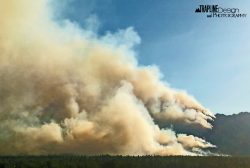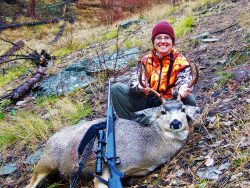Big bucks need high nutrient food, clean water and a place to hide.
That’s exactly the scenario left in the aftermath of forest fires. But it doesn’t happen every time forests go ablaze; when where and how fires burn can make the difference between wildlife wastelands and mule deer Mecca’s.
Forested lands all across the intermountain west can hold big mule deer bucks but you will need to begin narrowing your search by region like the northern Rockies which runs from Red Lodge, Montana to Glacier National Park and west to Northern Idaho. This area alone covers roughly 34 million acres of mountainous forests. Other fire-prone regions like the southern Rockies cover four states; Utah, Wyoming, Colorado and New Mexico.
Don’t let the sheer size of the landscape deter you though, there’s enough forest fire data available to plan a successful hunt. Maps showing recent forest fire activity will highlight things like when fires started and how big they were but it won’t show you pre and post fire deer densities.
Here’s how to use forest fires to help you put the crosshairs on a mountain monster this season.
Time of Year
Forests need time to recuperate so the time between the last fire and the year you are hunting is critical. Fires increase plant nutrients most notably important ones like potassium, phosphorous, calcium and potash which can result in healthy deer with big antlers. But timing your hunt for maximum deer numbers is critical.
“If a fire happens in July, don’t be there in October to hunt” says Tom Henderson owner and operator of Bitterroot Outfitters. For 26 years Henderson has watched the impact of forest fires on mule deer in big wild places like the Frank Church Wilderness of No Return in Idaho and the Bitterroot Mountains of Montana. Henderson thinks that over long periods of time fires can help improve hunting opportunities but that’s not always the case.
Burned areas need an entire growing season to recuperate but understanding the effects on hunting is complex. Weather, fire intensity and size of the fire all impact how deer numbers respond.
Size of the fire
Big fires with heavy fuels can be so intense that they sterilize soil for decades. “When fires get so hot that rocks are falling apart, that’s bad” says Henderson.
Small fires just 50 acres in size can create high density forage and are more likely to create small pockets of cover. But good hunting doesn’t have to come by way of small fires; much larger mosaic patterns that create good edge cover and leave patches of standing timber for bedding sites can have a similar effect.
Look for small fires that burned less than 500 acres or fires that created odd shaped patchworks of burned areas. Smaller low-intensity fires are more likely to provide successful under-burning which leaves big trees standing but creates more forage per acre by releasing nutrients into the soil without destroying it.
Fire Impact
There’s more to the impact of fires on mule deer than nutrition though. New underbrush also provides cover for fawns in the spring and opens up areas that make it easier for hunters to see deer during the fall. Areas burned in recent years are a good place to look for that trophy buck but Henderson cautions hunters to avoid overlooking land features that might also produce good bucks. “I try not to over analyze things but deer need enough timber left after a fire to bed down in. But, I also notice that areas choked with new growth or dense forests don’t produce as well as the classic November places for mule deer like the bitterbrush-mahogany southern aspects. Of course, if I see mule deer tracks at 7000’ heading towards a lodge-pole ridge I would follow them but it wouldn’t be the first place I’d look.” says Henderson.

Big mountain bucks grow old in the Rockies and hunters willing to study recent fire history can begin to narrow the search for unpressured deer to burned areas with specific characteristics. All it takes is a little fire data know-how and a willingness to venture into remote areas to put a mountain muley in your sights this year.